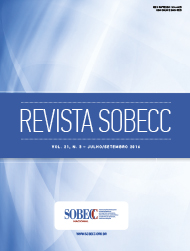Bases for safe use of thermal washer disinfectors emphasizing the release for use after technical intervention
DOI:
https://doi.org/10.5327/Z1414-4425201600030009Keywords:
Equipment maintenance. Detergents. Disinfection.Abstract
It is seen, in the daily routine of Material and Sterilization Centers (CMEs, acronym in Portuguese), that thermal washer disinfectors submitted
to technical interventions for correcting failures are released for use without evidence of operation following the required parameters for the effective
performance of cleaning and thermal disinfection. Given the importance of preventing healthcare-related infections, this study presents innovated
systematization of assays required for the release of thermal washers after technical interventions, as well as the necessary information to preserve such
equipment in optimal operation conditions. Safe release of the equipment should include the evaluation of temperature and time parameters compared
to data obtained during qualification, the conference of admitted detergent volume during cleaning, the evaluation of cleaning effectiveness with commercially
available monitors, the establishment of a change control, and a protocol for directing the requalification, following the Brazilian regulations
and international recommendations.
References
Giambrone GP, Hemmins HC, Sturm M, Fleischut PM. Information technology innovation: the power and perils of big data. British Journal of Anaesthesia. 2015; 115 (3): 339-42.
Brasil. Ministério da Saúde. Resolução da diretoria colegiada nº 15, de 15 de março de 2012. Dispõe sobre requisitos de boas práticas para o processamento de produtos para saúde e dá outras providências. Brasília, 2012.
Associação Brasileira de Normas Técnicas (ABNT) NBR ISO 15883, Lavadoras desinfetadoras. Parte 1: Requisitos gerais, termos, definições e ensaios. Rio de Janeiro: ABNT; 2013.
Arbeitskreis Instrumenten-Aufbereitung. Working Group Instrument Reprocessing. Instrument reprocessing: Reprocessing of Instruments to Retain Value, 10. ed, 2012. Disponível em:
http://www.a-k-i.org/index.php?id=11&L=1&id=11&no_cache=1&download=RB_GB_10_WEB_01.pdf&did=21
Brasil. Ministério da Saúde. Resolução da diretoria colegiada nº 55, de 14 de novembro de 2012. Dispõe sobre os detergentes enzimáticos de uso restrito em estabelecimentos de assistência à saúde com indicação para limpeza de dispositivos médicos e dá outras providências. Brasília, 2012.
Association for the Advancement of Medical Instrumentation (AAMI). Water for the reprocessing of medical devices. Arlington, VA: Association for the Advancement of Medical Instrumentation; 2007. AAMI Technical information report 34. TIR34:2007.
Associação Brasileira de Normas Técnicas (ABNT). NBR ISO 17665-2, Esterilização de produtos para saúde - Vapor – Parte 2: Guia de aplicação da ABNT NBR ISO 17665-1. Rio de Janeiro: ABNT; 2013.
Blechschmidt T. Routine Control of Washer-Disinfectors. Zentral sterilization central service. 2012; 5: 330-335.
Harty Z, Benz L. Washer monitoring: A must-have for today´s best practices (part 2). Healthcare Purchasing News – Self-Study Series. KSR Publishing, Sarasota. 2012; 30-33.
International Standard Organization. ISO 15883-5, Washer-disinfectors. Part 5: Test soils and methods for demonstrating cleaning efficacy; 2005.
Alfa MJ, Olson N. Comparison of washer-disinfector cleaning indicators: Impact of temperature and cleaning cycle parameters. American Journal of Infection Control. 2014; 42: e23-e26.
Alfa MJ. Monitoring and improving the effectiveness of cleaning medical and surgical devices. American Journal of Infection Control, 2013; 41: s56-s59.
Alfa MJ, Olson N, Al-Fadhaly A. Cleaning efficacy of medical device washers in North American healthcare facilities. Journal of Hospital Infection. 2010; 74: 168-177.
McCormich PJ, Schoene MJ, Dehmler MA, McDonnell G. Moist heat disinfection and revisiting the A0 Concept. AAMI – Industrial Sterilization: Challenges and Solutions for Medical Devices. 2016: 19-26.
Rosenberg, U. Thermal Disinfection – The A0 Concept and the Biological Background, Central Service, Volume 11. Suíça, 2003.
Uetera Y, Kawamura K, Kobayashi H, et al. Studies on Viral Disinfection: An evaluation of moist heat disinfection for HBV by using A0 concept defined in ISO 15883-washer-disinfectors. PDA J Pharm Sci and Tech. 2010, 64: 327-336.
Rutala WA, Weber JD, Gergen MF, Gratta A R. Efficacy of a washer –pasteurizer for disinfection of respiratory – care equipament. Infect Control Hosp Epidemiol. 2000; 21(5):333-6.
Associação Brasileira de Normas Técnicas (ABNT). NBR ISO 17665-1, Esterilização de produtos para saúde - Vapor – Parte 1: Requisitos para o desenvolvimento, validação e controle de rotina nos processos de esterilização de produtos para saúde. Rio de Janeiro: ABNT; 2010.
Downloads
Published
How to Cite
Issue
Section
License
By publishing in Revista SOBECC, authors retain the copyright of their article and agree to license their work using a Creative Commons Attribution (CC BY 4.0) International Public License, thus accepting the terms of this license. The CC BY 4.0 license allows others to distribute, remix, adapt, and create from the published article, even for commercial purposes, provided they give due credit to the creators of the work (authors of the article).
The authors grant to Revista SOBECC the right of first publication, to identify itself as the original publisher, and grant to the journal a non-exclusive license to use the work in the following ways: (1) to sell and/or distribute the article in hard copies and/or in electronic format; (2) to distribute parts and/or the entire article in order to promote the journal through the internet and other digital and printed media; (3) to record and reproduce the article in any format, including digital media.
With this license, authors can enter into separate contracts for non-exclusive distribution of the article (e.g., publishing in an institutional repository or as a book chapter), with acknowledgement of authorship and initial publication in Revista SOBECC. Authors are encouraged to publish and distribute their work online after publication in the Revista SOBECC, as this can increase the article's visibility and impact.
In line with the journal's policies, each published article will be assigned a CC BY 4.0 license, which will be visible on the abstract page and in the PDF of each article with the respective link to the license terms.











